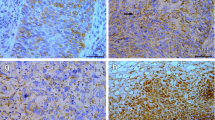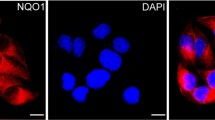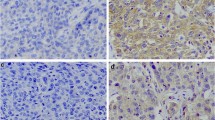Abstract
Objective
To investigate the expression of the high mobility group box1(HMGB1) in human cervical squamous epithelial carcinoma (CSEC) and to explore the relationship of HMGB1 expression to the differentiation degree, size, invasion and metastasis of CSEC.
Methods
Immunohistochemical staining of tissue microarrays and Western blot analysis were conducted to detect the expression of HMGB1 in the following tissue samples: 30 carcinoma in situ, 90 invasive CSEC without metastasis, 30 invasive CSEC with metastasis, 30 cases of normal cervical squamous epithelia.
Results
The positive-expression rate of HMGB1 was 58.7% (88/150) in CSEC, showing a significant difference compared to normal cervical squamous epithelia. The expression of HMGB1 was correlated with tumor size, invasion and metastasis of CSEC (respectively, P<0.01), but had no relationship with the degree of differentiation (P>0.05).
Conclusion
The over-expression of HMGB1 in CSEC might be a useful parameter as an indication of tumor invasion, metastasis, prognosis and overall biological behavior of human CSEC, as well as a noval target site for gene therapy.
Similar content being viewed by others
References
Völp K, Brezniceanu ML, Bösser S, et al. Increased expression of high mobility group box 1 (HMGB1) is associated with an elevated level of the antiapoptotic c-IAP2 protein in human colon carcinomas. Gut 2006; 55: 234–242.
Brunetti A, Manfioletti G, Chiefari E, et al. Transcriptional regulation of human insulin receptor gene by the high-mobility group protein HMG1(Y). FASEB 2001; 15: 492–500.
Pardo M, Garcia A, Thomas B, et al. The characterization of the invasion phenotype of uveal melanoma tumour cells shows the presence of MUC18 and HMG-1 metastasis markers and leads to the identification of DJ-1 as a potential serum biomarker. Int J Cancer 2006; 119: 1014–1022.
Ishiguro H. Receptor for advanced glycation end products (RAGE) and its ligand, amphoterin are overexpressed and associated with prostate cancer development. Prostate 2005; 64: 92–100.
Huang QX, Sun NF, Wang GB, et al. Expression of HMGB1 Protein in Human pancreatic carcinoma. Pract J Cancer 2004; 19: 19–23 (in Chinese).
Choi YR, Kim H, Kang HJ, et al. Overexpression of high mobility group box 1 in gastrointestinal stromal tumors with KIT mutation. Cancer Res 2003; 63: 2188–2193.
Hirata K, Takada M, Suzuki Y, et al. Expression of receptor for advanced glycation end products (RAGE) in human biliary cancer cells. Hepatogastroenterology 2003; 50: 1205–1207.
Evans A, Lennard TW, Davies BR, et al. High-mobility group protein 1(Y): metastasis-associated or metastasis-inducing? J Surg Oncol 2004; 88: 86–99.
Ito N, DeMarco RA, Mailliard RB, et al. Cytolytic cells induce HMGB1 release from melanoma cell lines. J Leukoc Biol 2007; 81: 75–83.
Zeh HJ 3rd, Lotze MT. Addicted to death: invasive cancer and the immune response to unscheduled cell death. J Immunother 2005; 28: 1–9.
Huttunen HJ, Fages C, Kuja-Panula J, et al. Receptor for advanced glycation end products-binding COOH-terminal motif of amphoterin inhibits invasive migration and metastasis. Cancer Res 2002; 62:4805–4811.
Takada M, Hirata K, Ajiki T, et al. Expression of receptor for advanced glycation end products (RAGE) and MMP-9 in human pancreatic cancer cells. Hepatogastroenterology 2004; 51: 928–930.
Bandiera A, Bonifacio D, Manfioletti G, et al. Expression of HMGI(Y) proteins in squamous intraepithelial and invasive lesions of the uterine cervix. Cancer Res 1998; 58: 426–431.
Sparatore B, Patrone M, Passalacqua M, et al. Activation of A431 human carcinoma cell motility by extracellular high-mobility group box 1 protein and epidermal growth factor stimuli. Biochem J 2005; 389:215–221.
Schlueter C, Weber H, Meyer B, et al. Angiogenetic signaling through hypoxia HMGB1:an angiogenetic switch molecule. Am J Pathol 2005; 166: 1259–1263.
Author information
Authors and Affiliations
Corresponding author
About this article
Cite this article
Fu, X., Du, X. & Hao, Q. Expression of HMGB1 protein in human cervical squamous epithelium carcinoma. Chin. J. Clin. Oncol. 5, 53–57 (2008). https://doi.org/10.1007/s11805-008-0053-z
Received:
Accepted:
Published:
Issue Date:
DOI: https://doi.org/10.1007/s11805-008-0053-z




